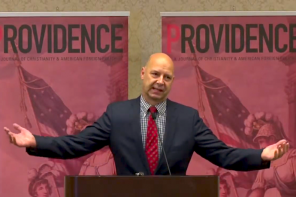As I write this, the opening scene of Lifetime’s new docu-soap, Preachers’ Daughters, is just airing. Judging from the reactions on Twitter, many tweeps are shocked by the “viewer discretion” warning. Reading their tweets, you can imagine them gesticulating in wild, Becky-Connor-circa-season-three-of-Roseanne outrage. Language? That’s unsuitable? For some audiences? On a show about preachers’ daughters?
Well, yes, Twitter. Did you not realize? A show about preachers’ daughters is going to contain language that’s unsuitable for some audiences. It will do so for exactly the same reason that a joke, friend-of-a-friend story, or limerick about a preacher’s daughter will contain language that’s unsuitable for some audiences. That’s the setup, the trope, the shtick, the genre, the formula, the thing we’ve come to expect. It’s why there isn’t a reality show called “Nondescript Teenagers Correctly Using the Quadratic Formula,” or a Grimms’ fairy tale called “The Tale of the Average-Looking Middle-Aged Woman Who Made Slow and Steady Progress Toward Her Goals,” or a joke that begins “A priest, a rabbi, and a paralegal whose firm specializes in property law all walk into a bar.”
Although we might wish otherwise, most of us know the story about the outwardly pious, but secretly lascivious young lady whose sexuality cannot be controlled as it ought, even when religious authority and familial authority converge in the parent under whose roof she lives. Whether we actually know such a person doesn’t really matter. We know the story, like we know stories about other familiar characters: heroes, bad stepmothers, scrappy orphans, blind seers, wise strangers, cuckolded husbands, and washed-up child stars.
(And yes, even in reality TV they are characters, reflecting the work and vision of producers and story editors as much as they reflect the goings-on of actual people living their lives.)
Who are the characters in Preachers’ Daughters?
Well, we have: 1) The Coleman Family: The parents, Ken and Marie, are the founding pastor and evangelist, respectively, at City of Refuge Pentecostal Church. Their youngest daughter, Taylor, is eighteen and says she fantasizes about being a porn star, although in context the remark is such a non-sequitur that it’s hard to know what she means.
The Colemans are also the only family of color depicted in the first episode and the promotional materials. What this will mean for a show and genre that rely so heavily upon stock characters? Hard to say after just one episode, but it’s worth keeping in mind. Preachers’ Daughters is clearly a show about the viewing public’s notions of girls and sexuality, some of which are regretful. Is it also a show about the viewing public’s ideas about race? (I’m guessing probably, but let’s give it another few episodes before saying more.)
2) The Koloff Family: The dad, Nikita, is a former pro wrestler who is now an evangelist. The mom, Victoria, has a Christian radio show, is a preacher, and does some sort of ministry where she exhorts young Christian women about not having sex before marriage. (She goes into biologically precise detail about precisely what she includes under the heading of “sex,” and is partly responsible for the language about which viewers are asked to exercise discretion.)
Nikita and Victoria are divorced, so their youngest daughter, Kolby, divides her time between them. Kolby seems pretty well-adjusted, actually. Her big plot arc for the first episode is that she’d like to date, so she asks each parent. They balk a bit, but they let her. (Victoria, though, makes her and her date sign a contract, in a scene that will make you sprain your Cringeus Headdeskifus muscle.)
3) The Perry Family: Dad Mark, mom Cheryl, and daughters Olivia, Emily, and Audrey. The first episode focuses on Olivia, an 18-year-old mother of a baby daughter. Her shocking confession is that she isn’t sure who the father is. Honestly, though, I liked this family. I don’t hold “purity” rhetoric in high esteem like they do, but they seem to care about each other and forgive each other, and so far the parents appear to be at least as interested in open communication as they are in, say, exerting control.
More so than the other two families, the Perrys seem genuinely to believe that appearing on this show will be a positive testimony that will help others. Again, though, it’s only the first episode. Maybe the other families just haven’t yet had a chance to talk about their motives for being involved.
In the end, though, you don’t watch Preachers’ Daughters to get a good idea of what it’s like to be a preacher’s daughter. (Or, well, at least I don’t.) For one thing, all of the daughters are, well, TV-beautiful—and most real adolescent girls aren’t.
No, the interesting thing about Preachers’ Daughters—and, often, the infuriating thing—is what it reveals about the viewing public that such a show exists. Lots of people have notions about girls and sexuality that cause them to see these stories as familiar enough to need no introduction, and yet compelling enough that they want to find out what happens.
Why do they do so? Well, that’s a far more complicated story.




